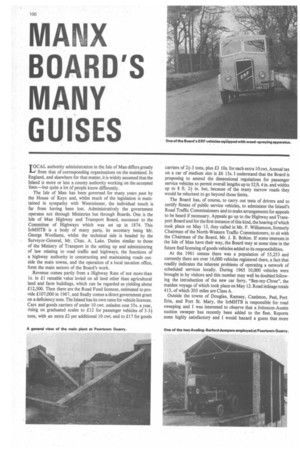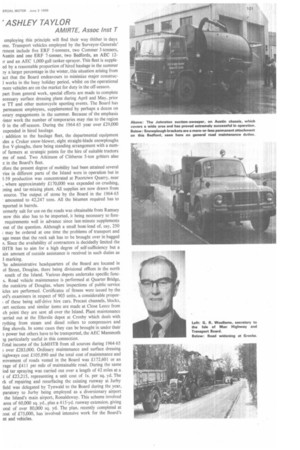MANX BOARD'S MANY GUISES
Page 102

Page 103

If you've noticed an error in this article please click here to report it so we can fix it.
TOCAL authority administration in the Isle of Man differs greatly la from that of corresponding organisations on the mainland, In England, and elsewhere for that matter, it is widely assumed that the Island is more or less a county authority working on the accepted lines—but quite a lot of people know differently.
The Isle of Man has been governed for many years past by the House of Keys and, whilst much of the legislation is maintained in sympathy with Westminster, the individual touch is far from having been lost. Administratively the government operates not through Ministries but through Boards. One is the Isle of Man Highway and Transport Board, successor to the Committee of Highways which was set up in 1874. This IoMHTB is a body of many parts, its secretary being Mr. George Woollams, whilst the technical side is headed by the Surveyor-General, Mr. Chas. A. Lake. Duties similar to those of the Ministry of Transport in the setting up and administering of law relating to road traffic and highways, the functions of a highway authority in constructing and maintaining roads outside the main towns, and the operation of a local taxation office. form the main sectors of the Board's work.
Revenue comes partly from a Highway Rate of not more than Is. in £1 rateable value levied on all land other than agricultural land and farm buildings, which can be regarded as yielding about £12,500. Then there are the Road Fund licences, estimated to provide £107,000 in 1967, and finally comes a direct government grant on a deficiency note. The Island has its own rates for vehicle licences. Cars and goods carriers of under 10 cwt. unladen cost 55s. a year, rising on graduated scales to £12 for passenger vehicles of 3-34, tons, with an extra £2 per additional 10 cwt. and to £17 for goods carriers of 2+-3 tons, plus £3 10s, for each extra 10 cwt. Annual tax on a car of medium size is £6 15s. I understand that the Board is proposing to amend the dimensional regulations for passenger service vehicles to permit overall lengths up to 32 ft, 4 in. and widths up to 8 ft. 2+ in. but, because of the many narrow roads they would be reluctant to go beyond those limits.
The Board has, of course, to carry out tests of drivers and to certify fitness of public service vehicles, to administer the Island's Road Traffic Commissioners and to make arrangements for appeals to be heard if necessary. Appeals go up to the Highway and Transport Board and for the first instance of this kind, the hearing of which took place on May 13, they called in Mr. F. Williamson, formerly Chairman of the North-Western Traffic Commissioners, to sit with the Chairman of the Board, Mr. J. B. Bolton, If some interests in the Isle of Man have their way, the Board may at some time in the future find licensing of goods vehicles added to its responsibilities.
At the 1961 census there was a population of 55,253 and currently there are over 16,000 vehicles registered there, a fact that readily indicates the inherent problems of operating a network or scheduled services locally. During 1965 10,000 vehicles were brought in by visitors and this number may well be doubled following the introduction of the new car ferry, "Ben-my-Chree", the maiden voyage of which took place on May 12. Road mileage totals 413, of which 203 miles are Class A.
Outside the towns of Douglas, Ramsey, Castleton, Peel, Port Erin, and Port St. Mary, the loMHTB is responsible for road sweeping and I was interested to observe that a Johnston-Austin suction sweeper has recently been added to the fleet. Reports seem highly satisfactory and I would hazard a guess that more employing this principle will find their way thither in days me. Transport vehicles employed by the Surveyor-Generals' rtment include five ERF 5-tonners, two Commer 3-tonners, Austin and one ERF 7-tonner, two Bedfords, an AEC 12r and an AEC 1,000-gall tanker-sprayer. This fleet is suppleed by a reasonable proportion of hired haulage in the summer oy a larger percentage in the winter, this situation arising from act that the Board endeavours to minimize major construe] works in the busy holiday period, whilst on the operational more vehicles are on the market for duty in the off-season.
part from general work, special efforts are made to complete ecessary surface dressing plans during April and May, prior le Ti' and other motorcycle sporting events. The Board has permanent employees, supplemented by perhaps a dozen on ■ orary engagements in the summer. Because of the emphasis tinter work the number of temporaries may rise to the region 0 in the off-season. During the 1964-65 year over £29,000 expended in hired haulage.
addition to the haulage fleet, the departmental equipment des a Croker snow-blower, eight straight-blade snowploughs five V-ploughs. there being standing arrangement with a numof farmers at strategic points for the hire of suitable tractors me of need. Two Atkinson of Clitheroe 5-ton gritters also e in the Board's fleet.
:fore the present degree of mobility had been attained several ries in different parts of the Island were in operation but in 3-59 production was concentrated at Poortown Quarry. near , where approximately £170,000 was expended on crushing, ,tning and tar-mixing plant. All supplies are now drawn from source. The output of stone by the Board in the 1964-65 amounted to 42,247 tons. All the bitumen required has to nported in barrels.
ormerly salt for use on the roads was obtainable from Ramsey now this also has to be imported, it being necessary to forerequirements well in advance since last-minute supplements out of the question. Although a small boat-load of, say, 250 ; may be ordered at one time the problems of transport and age mean that the rock salt has to be brought over in bagged a. Since the availability of contractors is decidedly limited the IFITB has to aim for a high degree of self-sufficiency but a am n amount of outside assistance is received in such duties as I marking.
he administrative headquarters of the Board are located in ol Street, Douglas, there being divisional offices in the north south of the Island. Various depots undertake specific funcs. Road vehicle maintenance is performed at Quarter Bridge, the outskirts of Douglas. where inspections of public service ides are performed. Certificates of fitness were issued by the trd's examiners in respect of 903 units, a considerable propori of these being self-drive hire cars. Precast channels, blocks, /eft sections and similar items are made at Close Leece from ch point they are sent all over the Island. Plant maintenance married out at the Ellerslie depot at Crosby which deals with rything from steam and diesel rollers to compressors and ling shovels. In some cases they can be brought in under their a power but others have to be transported, the AEC Mammoth ag particularly useful in this connection.
Iota] income of the IoM HTB from all sources during 1964-65 ; over £283,000. Ordinary maintenance and surface dressing aighways cost £105,890 and the total cost of maintenance and rovement of roads vested in the Board was £172,601 or an rage of £411 per mile of maintainable road. During the same iod tar spraying was carried out over a length of 42 miles at a t of £23,215, representing a unit cost of is. per sq. yd. The rk of repairing and resurfacing the existing runway at Jurby field was delegated by Tynwald to the Board during the year, paratory to Jurby being employed as a diversionary airport the Island's main airport, Ronaldsway. This scheme involved area of 60,000 sq. yd., plus a 415,1yd. runway extension, giving .otal of over 80,000 sq. yd. The plan, recently completed at cost of £75,000, has involved intensive work for the Board's nt and vehicles.








































































































































































